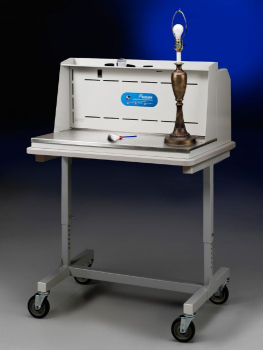Powder dusting evidence: Don’t risk health or resources
Fingerprint dusting is an effective, simple technique that can produce a big mess. Dusting evidence with latent print powders is a great forensic method, but fine latent print powders are not only a hygiene issue for the lab, but are also a health concern to technicians who breathe in the powders.
 The elements of wastefulness
The elements of wastefulness
To contain powders and protect themselves, many forensic scientists dust their evidence inside a chemical fume hood. In most cases, as a result of the powder mess that is created inside the hood, it becomes used exclusively as a “fingerprinting hood.” Once powder procedures are used in the fume hood, other types of procedures that normally would be done in that fume hood can no longer be conducted because it is impossible not to contaminate other samples with the remaining latent print powders, which can be very difficult to clean up.
Furthermore, the tempered air consumption of a chemical fume hood is one of the biggest operation expenses for a lab. Replacing tempered air that is exhausted by chemical fume hoods results in very high energy consumption. A typical 6' fume hood exhausts your air conditioner’s hard work at the rate of 470 cubic feet per minute and costs an average of $8,260 per year to run*.
Avoiding the money pit and the exposure risk
When using latent print powders, a ductless filtered enclosure with a downflow design offers many advantages over traditional chemical fume hoods. The ductless downflow enclosures are cleaner, more mobile and have a lower operating expense than traditional chemical fume hoods.
Ductless filtered enclosures are energy efficient and effective devices for the containment of fingerprint powders. Downflow enclosures utilize catch trays, prefilters and HEPA filters to remove the powders out of the air and return the tempered room air back into the lab. In addition, with ductless designs, auxiliary air, which chemical fume hoods require to operate efficiently, is not needed.
Another benefit to the ductless design is mobility. Downdraft powder enclosures do not require ductwork, so they can be easily moved around the laboratory. Installation is simple and inexpensive when compared with chemical fume hoods, which require the purchase and installation of ductwork and a remote blower.
Saving time with simpler powder cleanup
Because fingerprint powders are heavier than air and air within the enclosure is drawn downward, the powders can be easily collected in the catch pan below the perforated worksuface before they can create a mess.
Protector Downdraft Powder Stations are designed with valuable input from latent print examiners who use downdraft enclosures, reulting in several exclusive features:
- Open top design gives technician freedom of unrestricted movement and makes dusting large pieces of evidence easy.
- Stations can be linked side by side to create large continuous worksurfaces.
- Come with a shelf to hold powders, brushes and supplies.
- Flow-Zone™ Perforations in the stainless steel work surface maximize containment.
- Catch pan can be easily emptied without the need for tools.
- Available in 2' and 3' widths
.png)
Labconco offers a full line of forensic enclosures and equipment as well as ductless enclosures, chemical fume hoods, PCR Enclosures and biosafety cabinets.
* Based on average annual dollars per CFM of $7.00; fume hood operating 24 hours a day and 5 days per week (6240 hours per year). Average annual dollars per CFM range from $5.00 to $12.00 depending on geographic location. Closed sash air volume is based on NFPA 45 recommended minimum air volume of 25 CFM per cubic feet of interior space. Based on 8 hours per day with 18” sash opening and 60 fpm face velocity, and remaining time with sash closed.
| chevron_left | Ducted or Ductless? That depends... | Articles | Webinar: "Techniques in Forensic Science" | chevron_right |






